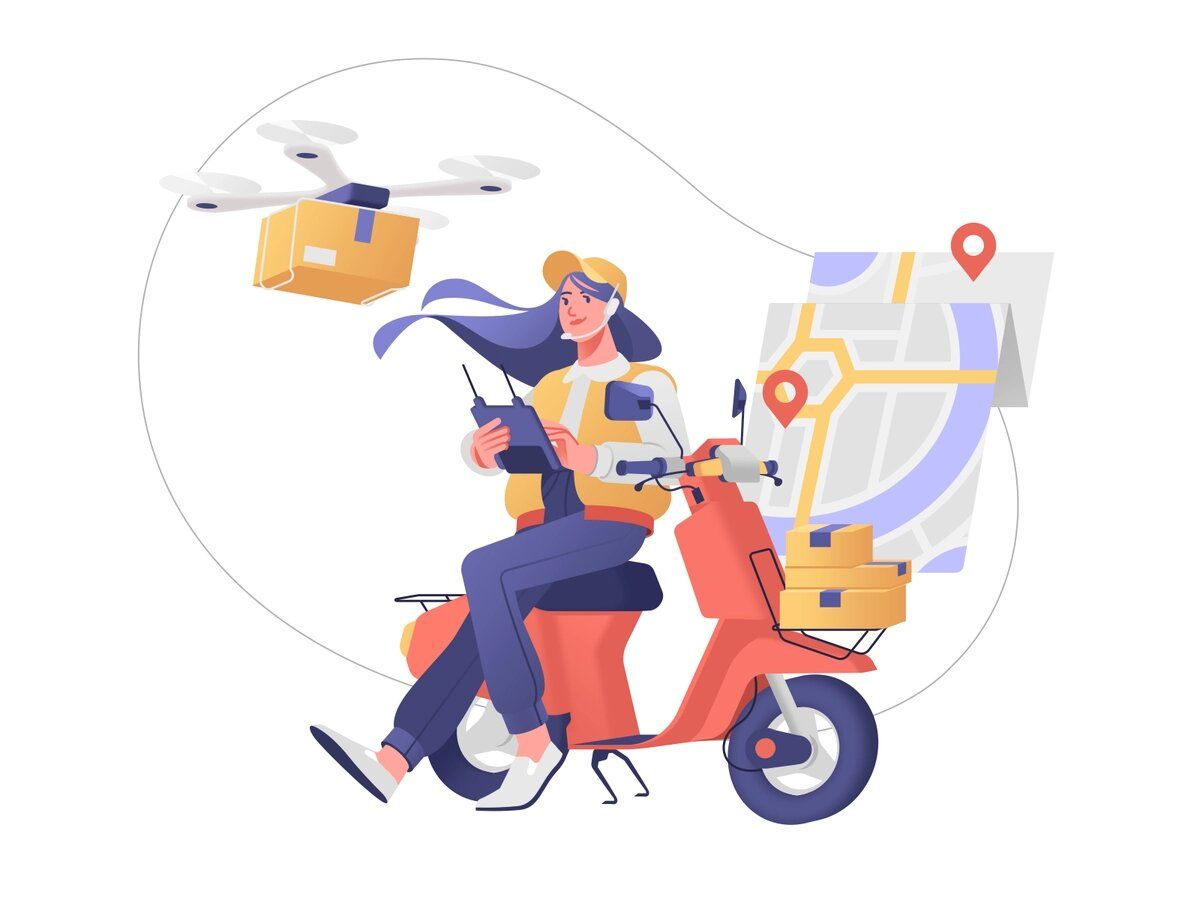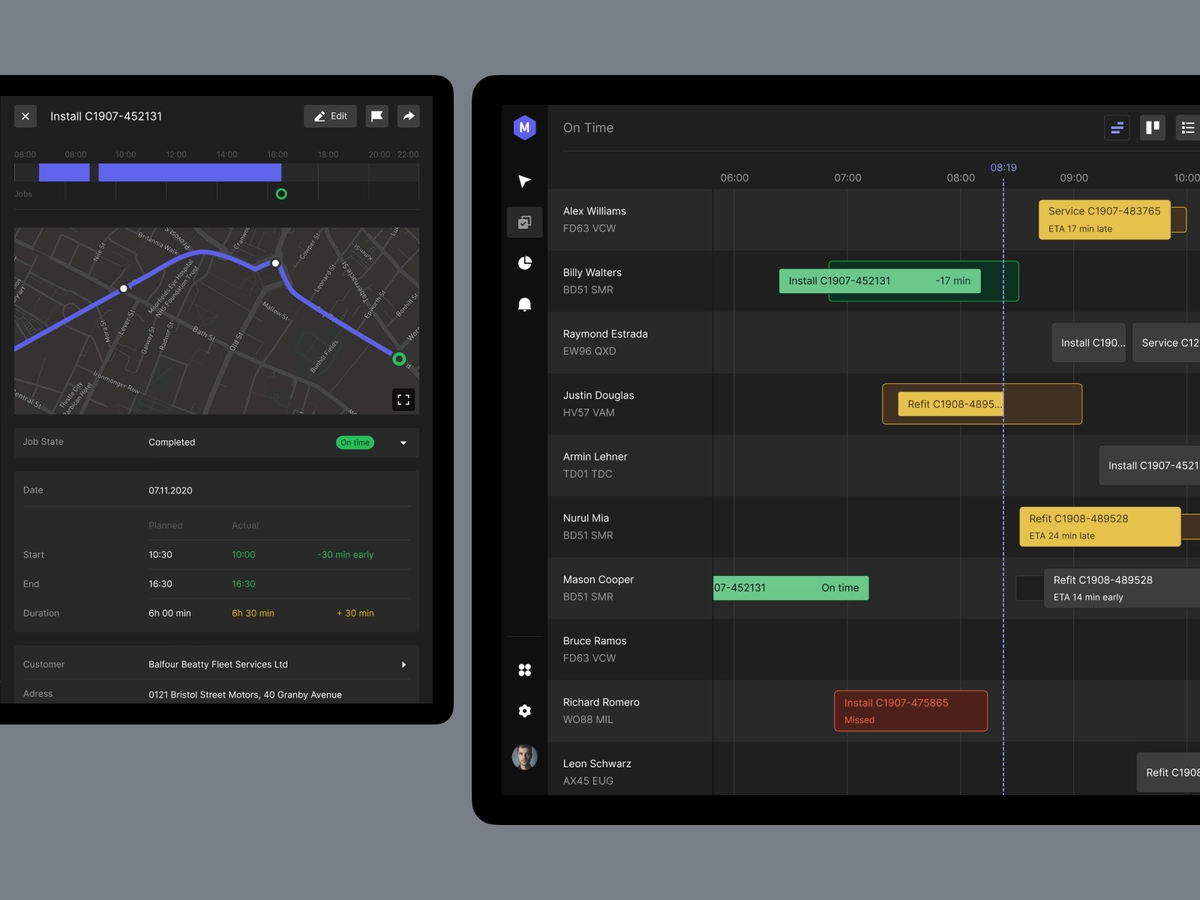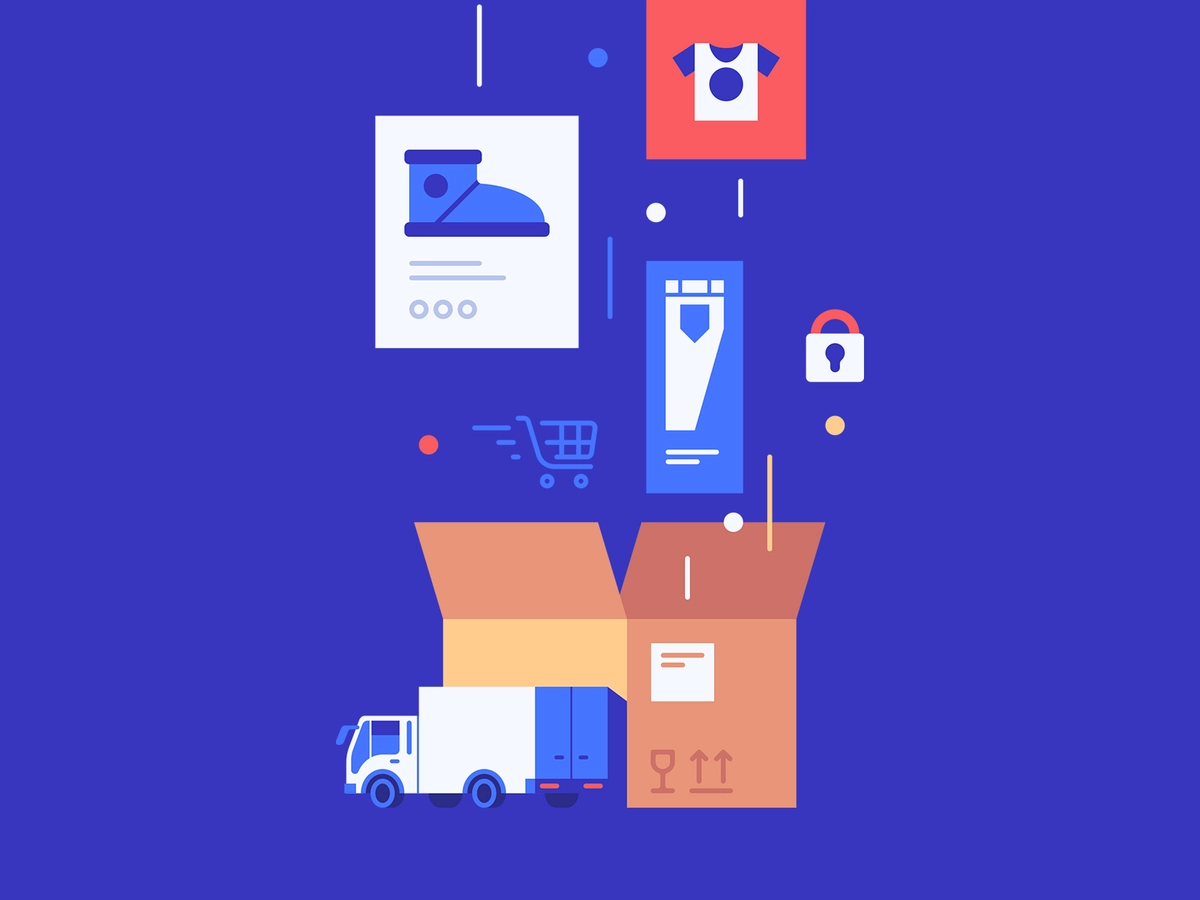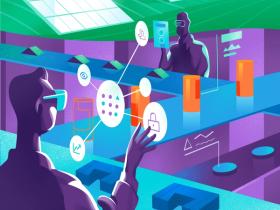IoT in Logistics & Transportation
Published: May 2, 2022
12 min read
In this article, you'll learn:
1
🧱 5 Layers of IoT in the Transportation Industry
2
📈 Benefits of using IoT in Logistics & Transportation
3
🚛 IoT Use Cases in the Logistics Industry
4
🔧 IoT Challenges in Logistics Processes
5
💡 Takeaways
Successful adoption rate of IoT technology in various industries continues its rapid rise throughout past years. Logistics and transportation are not exceptions at all, as implementing IoT features crucially benefits both of these branches in different ways.
According to IoT in Logistics Market Research Report, the global IoT logistics market reached a value of about $34.5 million in 2019. As the research states, almost a three-time rise in a market value is highly expected by 2030, predictably reaching about $100 million.

Example of an IoT application for transportation and logistics (image by Adam Balazy)
Let’s now find out what are the key benefits of adopting IoT in the logistics and transportation industry, along with the main use cases and challenges that companies may encounter in the supply chain process.
🧱 5 Layers of IoT in the Transportation Industry
An IoT architecture in transportation presents 5 operational layers to set up a trustworthy system of goods shipment. These are:
- an application layer;
- a service layer;
- a sensing layer;
- a communication layer;
- and an infrastructure one.
Every piece of data requires proper communication to be delivered right into the service layer after being sensed and stored in an infrastructure layer. For a better understanding of the Internet of Things architecture in the transportation cycle, let’s have a brief acquaintance with these layers and their responsibilities:
Layer | Task | Components/Means | ||
|---|---|---|---|---|
Application Layer | Granting clients abilities to monitor the transportation of goods, vehicles, and road conditions, etc. via an application | Mobile applications, web & mobile dashboards, web applications | ||
Sensing Layer | Gather data from the sensors integrated into smart vehicles and other tracking devices | Cameras, RFID tags, Beacons, various tracking and monitoring systems and gadgets | ||
Communication Layer | Providing informational bridges between service and sensor layers. Transferring collected data | Wi-Fi, Cellular data, Wired Networks | ||
Service Layer | Structuring the gathered data and processing it per user’s requests through the application layer | Logistics Service Platform, Fleet Vehicle Service Platform | ||
Infrastructure Layer | Improving the quality and reliability of performance by using specific technologies | Cloud Storages, Big Data, Mapping Services | ||
📈 Benefits of using IoT in Logistics & Transportation
In modern world IoT abbreviation may also be considered as “innovation” and “improvement” for almost every possible case. Wherever the Internet of Things gets involved, it becomes significantly beneficial for the system, whether it’s healthcare, fitness, or just an ordinary housekeeping one. As we are talking about the transportation and logistics industry, let’s see what are the benefits of implementing IoT technology.
- Improved Analytics. The higher level of IoT adoption, often starting with Internet of Things prototype development, leads to gathering more useful data by companies. With the right way of gathering and presenting the information, it becomes easier to build an efficient strategy that leads to greater success. Various sensors allow to analyze the inventory assets and transporting qualities to find the best way to optimize any logistics process. More data leads to better decisions.
- Saving. By the means of IoT in logistics and transportation, companies are given a chance to predict and avoid potential financial damage when it comes to unexpected failures. Factoring in the IoT software development cost allows for predictive capabilities, leading to quicker reactions to malfunctions and quality maintenance, thereby achieving higher profit and reducing waste on fixing.

Logistics IoT applications are great in terms of predictive analytics, route optimization and transportation monitoring (image by Shakuro Graphics)
- Environment. Various sensors that transmit data in real-time grant flexibility in avoiding congestion and quick adaptation to sudden traffic pattern changes. Exactly the reduction of congestion and lesser energy waste because of quick reaction to new traffic patterns shows a great impact on the environment.
- Safety. IoT in logistics provides better security for employees in terms of fast issue detection. In case of an unexpected equipment issue, IoT sensors will notice it and react much faster, which can grant additional employee safety. For example, it doesn’t only provide real-time quality monitoring, it also may be programmed to automatically call an ambulance whenever sensors detect an emergency.
🚛 IoT Use Cases in the Logistics Industry
Now that we are more familiar with the general advantages of adopting IoT in logistics and transportation, let’s see how it can be specifically implemented in different use cases.
Inventory Tracking
Thanks to IoT systems, it’s easier to monitor the safety of goods as well as quickly locate required products across gigantic warehouses. Inventory tracking also minimizes human-storage interactions which affects the number of possible inaccuracies.

Inventory tracking dashboards are used by logistics managers for predictive analytics and analyses (image by Istiak Ahmed)
Amazon Prime’s case is a good example here. Surprisingly, in Amazon’s warehouse items are not stored by similarity, vice versa the placing order is absolutely random. The reason behind this is a route management system that lets workers avoid wasting time sorting similar goods. Before placing an item on a shelf, employees scan it and automatically transfer the information about its location to the database. Whenever any product is ordered, a computer automatically creates the fastest route to its location for an employee, making the system even more time-saving.
Warehouse Management
Implementing the Internet of Things in warehouse management systems significantly impacts overall convenience and helps avoid a lot of potential issues.
With those sensors, it’s possible to grant real-time tracking for goods that require special conditions in terms of storage. For example, remotely managing temperature levels hugely decreases the risks of an item being stored improperly, as the sensors allow employees to quickly react to any thermal issue and fix it without damaging the goods.
Besides the sensor integration to achieve peak efficiency, companies automatize warehousing with the help of robots and drones. Thus, Cainiao (China Smart Logistic Network) firm majority-owned by Alibaba opened a warehouse automated by over 700 robots to be completely prepared for a Singles’ Day shopping festival in 2018.
Smart Fleet Management
IoT sensors considerably increase both vehicle tracking and driver monitoring, showcasing how to develop companion apps for efficient fleet management. With their implementation, it becomes possible to collect more information not only about the vehicle’s condition but also about the driver’s behavior. The advantages of more intense fleet management are quick reactions to sudden failures and the ability to track and prevent possible vehicle damage.

Example of smart fleet management presented in a timelined dashboard (image by Eugene Paryhin)
For example, IoT sensors let you monitor fuel consumption levels, tire pressure, and the conditions of other inner parts of the vehicle. It also becomes possible to gather information about driving habits of an employee. Tracking the number of stops it takes him to travel a certain distance, average delivery speed, combined with the fuel consumption rates presented, gives an opportunity to create an optimal driving strategy so that the deliveries become more efficient.
Predictive Maintenance
Maintenance and operation costs are usually a huge issue for various logistics companies in the transportation sector. Imagine the average cost of unexpected maintenance for a company conducting massive vehicle fleets. Basically, it may cost millions for a logistics company to deal with the malfunction they weren’t expecting at all.
However, in this situation Internet of Things implementation grants an incredible solution. As we can’t avoid maintaining vehicles from time to time, what if we change the word near our maintenance from “unexpected” to “predictive”? It gets much cheaper for a logistics company to maintain a vehicle when the malfunction is at its early stage. Thanks to IoT sensors monitoring every vital condition, spotting the first signs of a possible failure lets logistics companies save a significant amount of money on dealing with it.
Cargo Integrity Monitoring
With the help of smart labels, it’s now possible to track the conditions of any transported item and monitor the integrity of packages and delivery boxes.

It is much easier now to ensure a cargo’s integrity during transportation thanks to smart labels (image by Muharrem Huner)
The most popular use for such smart labels comes when the goods require special conditions to be maintained for quality delivery. For example, constant monitoring of frozen edible goods helps to prevent company losses in case of unexpected malfunction during transportation services.
Also, by using the smart tags, logistics companies may even reduce financial damage from the goods being stolen, as labels’ GPS tracking capacities may become quite handy.
As an example, there is a case study that covers the implementation of IoT-CMS in AOC Limited that covers the cold chain logistics with Chevalier Cold Storage and Logistics Limited in Hong Kong. In a four-stage system implementation and a 10-day data gathering, AOC Limited became able to monitor cargo conditions along with providing quality storing in real-time.
Drone Based Delivery
Among all the IoT solutions for supply chains, adopting drones for the transportation process has the greatest potential. As timely delivery is a top priority, minimizing human and route factors with IoT technologies will definitely be beneficial. Drone-based delivery not only makes route optimization strategies easier but also significantly reduces operating costs for the service provider. Transportation IoT technologies such as drones are not yet ready for a complete adoption, however, some loud announcements have already been made.
So Amazon is already making progress in the eventual release of drone-based deliveries, and in the nearest future, we will see the beginning of the revolution in the transportation and logistics sector.
🔧 IoT Challenges in Logistics Processes
According to the Internet of things and its challenges in supply chain management research, adopting IoT comes with some challenges. Let’s take a look at the ones related to the supply chain process along with the issues that you shouldn’t ignore.
Integration
When we consider various potential challenges the first category to think of is definitely the integration part. What are the issues specifically related to integrating IoT features that shouldn’t be missed? Let’s find out the main ones.
- Scalability. As the smart devices in the supply chain will mostly serve a specific purpose it will lead to them being customized and set up exactly for the clear-cut usage in particular cases. It should be clear that with most of the possible customizations, there is a high risk of IoT being unscalable in the supply chain as well as the chances for device reusage in some diverse use cases considerably lower.
- Business model modifications. As we are talking about integrating IoT features into an already existing and functioning business, it’s vital for the chosen model to be suitable for such adoption. It is crucial that every component of the existing supply chain (manufacturers, suppliers, and distributors) can fit into the new business model and not be in disfunction. Or there is a risk that a previous business model will be no longer applicable to cover up the consequences of such an experiment.
- Financial awareness. IoT adoption without a doubt is a significant upgrade for a company, however, everything has its own price. It may be very challenging financially for many logistics companies to implement IoT features they are hugely expecting in their supply chain business. So taking such an important step without the realization of potential operational costs required may be very damaging to a company’s prosperity.
Operational
This section of challenges consists of the issues related to operational processes. What points should be considered in order to set up the highest functioning level and what usually stops the successful adoption of IoT in logistics industries.
- Weak planning stages. As IoT is a relatively new technology for companies to adopt, seeking expert IoT app development services can provide the necessary support and expertise for its integration. Unfortunately, it’s not enough to just realize the importance of IoT for a logistics business. Then there should always come thorough research and a clear strategy on how to adopt IoT properly and adapt it in the most beneficial way for a company. Nowadays, the lack of knowledge in IoT and consequent weak planning stages prevent many companies from accessing the benefits of IoT.
- Security and privacy issues. Successful IoT integration is impossible without setting up proper security levels. As cyber intrusions and data leaks may cause severe damage to a company both financially and reputationally, security should be considered the top priority.
- Storage management. This challenge is partially related to the energy consumption issue we mentioned before. Logistics IoT devices generate a lot of information that should be stored properly in order to be practically convenient for use and presentation. The means of storing the big amount of generated data also require power for proper function, which should also be considered before integrating smart devices.
Social
Challenges that come with IoT are not only about operational or integration issues. It’s important to be aware of the challenges that involve social interactions such as gaining trust or re-educating employees. Let’s take a deeper look at them.
- Establishing Trustworthiness. Whenever a company decides to adopt the IoT, it often becomes necessary either to hire additional employees or to train some of them to be competent enough. In any of these cases, it becomes vital to gain trust among the stakeholders as well as to reach a complete agreement for the Internet of Things adoption. If a bigger percentage of them don’t have any idea how things operate with IoT, it may take some time to get their understanding. Unaware parties should trust the process and be confident about the positive outcome of implementing an IoT technology they have no clue about.
- **Constant Environmental Variability. **Although environmental challenges are also presented separately on the list, this challenge is not about ecology. The point is that almost everything in our world is dynamic. Whether it’s changing technologies or user behavior — nothing is absolutely stable and thus can’t be easily predicted. That’s why Internet of Things implementation involves adopting constant updating and adaptation to keep up pace with the environmental dynamics.
Environmental
After describing technical and social challenges we should also consider environmental awareness and the issues that lay beyond it. When it comes to the environment there are several challenges.
- Energy Issues. Nowadays the number of created smart devices continues to rise rapidly. Thus, there are also increases in the amount of energy required to power them. Although the whole world is looking forward to fully ecological power consumption, renewable energy sources may not be enough to fulfill the new power demands. Implementing a big number of smart devices may require a step back to traditional energy sources, which hugely affects the ecology.
- E-Waste. The more Internet of Things devices are manufactured the more technological disposals there will be. Basically, whenever an IoT device substitutes another gadget in a system — the e-waste rate increases. The disposal of various machinery and peripherals should be thoroughly considered with the adoption of the Internet of Things.
💡 Takeaways
In conclusion, we can confidently state that adopting the Internet of Things for Logistics and Transportation businesses is significantly beneficial to improving safety, profit, and reliability. The number of possible use cases for IoT systems is game-changing, and shouldn’t be underestimated. If you choose a prosperity course for your logistics or transportation project — implementing IoT is definitely the most beneficial and reliable step you can take.
If you have any questions or need help with integrating IoT features into your logistics or transportation project, let us know. We will be happy to help you meet your business needs with an outstanding product!
Was it helpful?
Read also

How to Create a Fitness App: Process, Costs, Estimates and Challenges

What is Prototyping in IoT and Some Practical Advice

What is IoT Device Management?
Our clients say
![Stormotion client Max Scheidlock, Product Manager from [object Object]](/static/33294af91c38256bcd5a780ddc41861a/b0e74/max.png)
They understand what it takes to be a great service provider, prioritizing our success over money. I think their approach to addressing ambiguity is their biggest strength. It definitely sets them apart from other remote developers.
Max Scheidlock, Product Manager
HUMANOO
